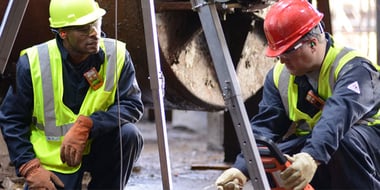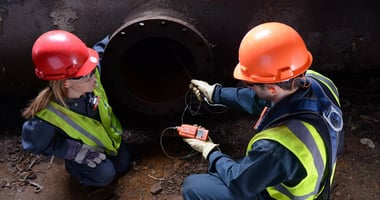Key Takeaways:
- Have a Clear Plan: Document confined space procedures, including how and when to test for gas hazards, and make them easily accessible to your team.
- Train Your Team: Frequent, hands-on training with gas detection equipment is key to preventing avoidable deaths.
- Use the Right Tools: Reliable gas detectors, proper bump testing, and continuous monitoring can make all the difference in keeping workers safe.

Despite tight regulations and technological advancements, confined space entry accidents and fatalities remain a problem.
In fact, an average of two people die each week from a confined space incident, and of all confined space deaths, 60% are would-be rescuers who die while trying to save a peer.
Confined spaces present unique dangers that workers must be prepared to handle.
To minimize this risk, a thorough confined space entry process is crucial to keeping the job safe:
1. Have a Plan
To make confined space entries safer, you need clear, written procedures for how to detect gas hazards.
- Understand the confined space regulations in your region,
- Document the steps everyone needs to take before, during and after a confined space entry.
- After documenting your confined space safety plan, make sure all employees can access it quickly and easily.
At minimum, your plan should include details on what equipment should be used to detect atmospheric hazards, when the atmosphere should be tested, and the order in which hazards should be assessed.
2. Train Your Team
Once you have a plan for how to detect gas hazards in confined spaces, you need to train your operators.
Training your equipment operators on safe confined space entries is critical yet often overlooked. In fact, a study researching confined space deaths recommends training employees often as the first and most effective way to curb avoidable deaths on the job.
To address this problem before it leads to a tragedy, give your team proper training on gas detectors so they understand how the sensors function, how to take readings and how to respond to varying alarms. This training should be repeated periodically to keep the information front of mind.
3. Bump Test, Zero, and Calibrate
Once you know your hazards, select the best-in-class tools to identify them.
An essential tool needed when entering a confined space is a direct-reading gas detector with the right sensors for your application.
- Bump test and zero monitors before each use.
- Calibrations should be performed monthly or whenever a monitor may have been exposed to sensor poisons or inhibitors.
Bump testing (also known as a functional testing), zeroing, and calibrating sensors regularly is crucial– skipping even one of these steps puts an operator at risk of entering a confined space without a gas detector that can alert to deadly hazards.
 4. Test Before Entry with a Sampling Pump
4. Test Before Entry with a Sampling Pump
Regulations generally require testing the atmosphere within a confined space with a direct-reading monitor before a person enters.
Gas detectors with sampling pumps and a length of flexible tubing or a probe are ideal for drawing remote samples from confined spaces prior to entry.
During pre-entry sampling, use the 2x2 Rule. The rule states that when using a sampling pump, you should wait two minutes plus two seconds for every foot of tubing. This process should be repeated at the top, middle and bottom of the space because different gases settle at different heights, depending on their weight relative to air.
5. Monitor Hazards Throughout the Entry
The safest procedure is for all entrants to wear a direct-reading personal gas detector that continuously monitors for potential hazards. You can improve safety even further by using connected monitors like the Ventis® Pro5 or Radius® BZ1, enabling monitors to wirelessly share gas readings and alarms so the attendant always knows exactly what’s happening within the confined space. If conditions trend toward danger, workers will have the notice they need to exit the confined space safely.
Confined space work is risky, but with the right plan, training, and tools, it doesn’t have to be. At Industrial Scientific, we’re here to help you protect your team with reliable gas detection and expert support.
Want to dig deeper into confined space safety? Download our free eBook for practical tips and insights that could save lives.
.jpg?width=380&height=228&name=confined%20space%20white%20paper%20255x180%20(2).jpg)


